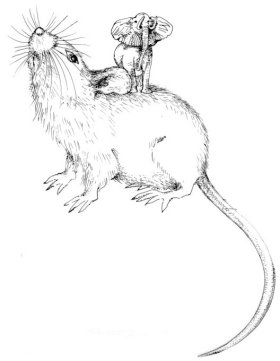Today, we look at the question of size. The University of Houston's College of Engineering presents this series about the machines that make our civilization run, and the people whose ingenuity created them.
We understand things on the scale that we experience them. We're often suprised by how differently things behave when they're very small or large. To see what I mean, try this experiment. First find a very small and a very large metal sphere -- say a BB and the big steel ball used in the shot put. Now drop each of them from a height of a few feet into a swimming pool. You'll see that the shot splash isn't at all like a scaled-up BB splash. The large shot sends out a sheet of water that breaks into a fine spray of drops. There are only a few drops in the BB splash.
Before we had today's computer simulations, that was how we could always tell whether a naval battle in a movie was a scale model or full size. The splashes never looked right in the scale model. (Watch an old WW-II vintage movie about a naval battle. You'll see.)
I once knew a badly crippled construction worker. He'd been working on the ledge of a building that was being demolished when he saw a two-ton scoop swinging toward him -- very gently -- very slowly. He put out his hands to stop it as he might have stopped a child on a swing. And when it reached him, it very gently crushed him. His experience with playground swings had grieviously misled him about the behavior of two-ton scoops.
Engineers think a lot about making scale models of big prototypes. We wouldn't get very far if we had to make full-size wind-tunnel tests of a Concorde SST. The trick is to set the conditions in a small model so its behavior is similar to the large prototype. For example, we really could use a BB experiment to learn about the large shot hitting water, if we changed two things. The BB would have to move much faster than the shot, and we'd have to put just the right amount of detergent in the water to cut its surface tension.
What the theory of modeling does is to tell us how to stretch the dimensions of all the variables -- masses, speeds, material properties -- into universal values. When we do this, funny things happen. For example, we can learn about the movement of microorganisms in our body fluids by making laboratory experiments with large objects moving very slowly through cold honey.
The problem of modeling is one part of a general problem we have to face whenever we design things. We have to find ways to see what's not obvious to our eyes. We have to find ways to predict complicated behavior before it becomes part of our experience.
I'm John Lienhard, at the University of Houston, where we're interested in the way inventive minds work.
(Theme music)
J. H. Lienhard IV and J. H. Lienhard V, A Heat Transfer Textbook. 3rd ed., Cambridge, MA: Phlogiston Press, 2004, Click here for a free copy. See Chapter 4.
For another take on modeling, see Episode 1407.

Image by Maria Szigmond Baca, permission of Peter Gordon